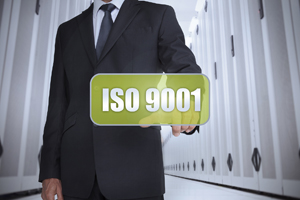
ISO 9001 Certification
Quality Management System
ISO 9001 certification sends a clear message that your organization is committed to high standards and continual improvement. ISO 9001 certification is achieved implementing a Quality Management System that conforms to the International Standard ISO 9001:2008 Quality Management Systems – Requirements. This is the only ISO 9000 standard for which certification can be gained.
This standard is intended for use in any organization regardless of size, type or product including service. It provides a number of Quality Management System requirements which an organization needs to fulfil. In order to achieve ISO 9001 certification an organization needs to demonstrate its ability to consistently provide product that meets customer and regulatory requirements through the effective application of the quality management system including processes for continual improvement.
ISO 9001 requires your quality management system to include procedures that cover all key processes, the monitoring of processes to ensure they are effective, to keep adequate records, checking output for defects, to take corrective action where necessary, to reviewing the quality system for effectiveness and for a focus on continual improvement within the business.
The key sections of ISO 9001 where the requirements are defined are section 4: quality management system, section 5: management responsibility, section 6: resource management, section 7: product realization and section 8: measurement, analysis and improvement.
Certification to the ISO 9001 standard must be carried out by an accredited certification body. Accreditation is a formal, third party recognition of competence to perform ISO 9001 certification. Certification bodies for ISO 9001 are accredited to International Standard ISO/IEC 17021:2011 to provide quality management systems certification to ISO 9001:2008. When a certification body has accreditation to the ISO/IEC 17021 standard you can be confident that it has been successful at meeting the requirements of international accreditation standards.
The key element to ISO 9001 certification is having management commitment to meet the requirements of the standard including meeting customer requirements, implementing processes for continual improvement and providing the resources needed to achieve this. The starting point of this process is purchasing a copy of the standard, conducting staff training and familiarization with the standard then conducting a gap analysis to identify areas where your current quality management system needs to be improved. The ISO 9001 standard can be purchased from ISO for 122 Swiss Francs here.
Once the gaps in the quality management system have been addressed and internal audits and management reviews indicate that the system is operating effectively you are ready to move on to choosing a certification body to assess your quality management system. It is advisable to obtain several quotes for comparison and also choose a certification body you believe to be reputable, especially as you will use their logo in your literature when you communicate your certification. Many certification bodies advertise ISO 9001 certification fees that are proportional to annual turnover, making the certification achievable and affordable for all sizes of organizations.
ISO 9001 certification is normally carried out in two assessment stages. Stage 1 is to confirm the scope of certification and the readiness of your organization for full assessment. At this stage an auditor will check your to confirm quality manual conforms to the requirements of the ISO 9001 standard and produce a report that identifies any non-compliance or potential for non-compliance and agree a corrective action plan if required. Normally you must be able to demonstrate that your quality management system has been fully operative for a minimum of three months. The final part of stage 1 is to agree an assessment plan and confirm a date for the stage 2 assessment. The length of the stage 2 assessment will depend on the size and complexity of your operation.
Stage 2 is an on-site visit to confirm that the quality management system fully conforms to the requirements of ISO 9001:2008 in practice where an auditor or audit team conduct sample audits of your quality management system. During the visit the auditor documents how your system complies with the standard and reports any non-compliances or potential for non-compliance. Based on the auditor’s findings you will be recommended for certification or if the auditor identifies any major non-conformance, you cannot be certified until corrective action is taken and verified.
After the stage 2 assessment he auditor’s report is submitted to their certification body for review. The certification body will confirm is certification has been approved and issue a certificate or seek further evidence of corrective action if non-compliances were identified and not closed out to their satisfaction.
The cost of getting your quality management system ISO 9001 certified will vary from organization to organization and certification body to certification body. Typically the initial stage 1 and stage 2 assessments take three days and are followed by two surveillance visits a year from then on. This means ISO 9001 certification initially costs around $3,000 – $5,000 and ongoing certification around $1,500 – $3,000 annually until the recertification audit which occurs after three years. Although this may seem a significant cost, it is not when considering the improve marketability of your organization, senior management should view ISO 9001 certification as a profitable business investment.

